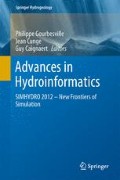Abstract
Until now, the fine representations of the complex hydraulic phenomena such as Vortex rely on physical modeling for industrial purposes. EDF has been testing the 3D CFD code “Flow 3D©” for free surface flow simulation since five years. The main difficulty of using finite elements programs is the relevance and the stability of their numerical results. EDF decided to test in the field of vortex how reliable Flow 3D is. Flow 3D is a commercial CFD code using VOF method with a rectangular mesh. In this study, it is assumed that flow is liquid water with an interface simulated by VOF method. This study is based on a schematic hydraulic experimental model realized in the EDF-R&D laboratory. The chosen case is a simple configuration of a vertical downward drain hole. The basin is one meter length and around a half meter width. The water level is fixed, and the flow rate is adjustable. The main advantage of this experiment is that the geometry is easy to simulate with 3D CFD software. In this configuration, it is ensured that a vortex phenomenon exists and that it is stable during experimentations. An aerated vortex with no air flow rate has been chosen for the validation case. The aerated vortex length reaches the basin bottom. The first goal of the 3D CFD simulation is to check whether Flow 3D© is able to represent a vortex when it physically exists. The second objective is to find the simplest set of CFD parameters that represents the vortex as it appears in the physical experimentation.
Access this chapter
Tax calculation will be finalised at checkout
Purchases are for personal use only
References
De Siervi, F., Viguier, H.C., Greitzer, E.M., & Stan, C.S. (1982). Mechanisms of inlet-vortex formation. Journal of Fluid Mechanic, 124, 173–207.
Levi, E. (1991). Vortices in hydraulics. Journal of Hydraulics Engineering, 117(4), 399–413.
Hunt, J.C.R., Wray, A.A., Moin, P. (1998). Eddies,stream, and convergence zones in turbulent flows. Centre for Turbulence Research Report CTR-S88, 193.
Jain, A.K., Ranga Raju, K.G., & Garde, R.J. (1978). Vortex formation at vertical pipe intakes. Journal of the Hydraulics Division, ASCE, 104(10), 1429–1445.
Padmanabhan, M., & Hecker, G.E. (1984). Scale effects in pump sump models. Journal of Hydraulic Engineering, 110(11), 1540–1556.
AFNOR (2009). Fascicule de documentation de l’AFNOR n° FD CEN/TR 13930. Pompes rotodynamiques: conception des ouvrages d’aspiration: recommandations d’installation des pompes.
ANSI (1998). Pump intake design. American National Standard Institute ANSI/HI 9.8-1998.
Tokyay, T.E., Constantinescu, S.G. (2005). Large eddy simulation and reynolds averaged Navier-Stokes simulations of flow in a realistic pump intake: A validation study. Impacts of global climate change (pp. 1–12). doi:10.1061/40792(173)423
Minisci, E., Telib, H., Cicatelli, G. (2005). Hydraulic design validation of the suction intake of a vertical centrifugal pump station, by use of computational fluid dynamic (CFD) analysis. Proceeding of the ASME Fluids Engineering Division Summer Meeting and Exhibition, Houston, USA, June 19–23 2005.
Chong, M.S., Perry, A.E., & Cantwell, B.J. (1990). A general classification of three-dimensional flow fields. Journal Physics of Fluids, A2(5), 408–420.
Levy, Y., Degani, D., & Seginer, A. (1990). Graphical visualization of vertical flows by means of helicity. AIAA Journal, 28(8), 1347–1352.
Jeong, J., & Hussain, F. (1995). On the identification of a vortex. Journal Fluid Mechanic, 285, 69–94.
Author information
Authors and Affiliations
Corresponding author
Editor information
Editors and Affiliations
Rights and permissions
Copyright information
© 2014 Springer Science+Business Media Singapore
About this chapter
Cite this chapter
Guyot, G., Maaloul, H., Archer, A. (2014). A Vortex Modeling with 3D CFD. In: Gourbesville, P., Cunge, J., Caignaert, G. (eds) Advances in Hydroinformatics. Springer Hydrogeology. Springer, Singapore. https://doi.org/10.1007/978-981-4451-42-0_35
Download citation
DOI: https://doi.org/10.1007/978-981-4451-42-0_35
Published:
Publisher Name: Springer, Singapore
Print ISBN: 978-981-4451-41-3
Online ISBN: 978-981-4451-42-0
eBook Packages: Earth and Environmental ScienceEarth and Environmental Science (R0)

